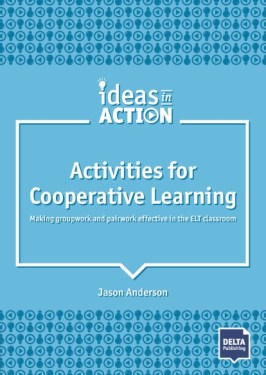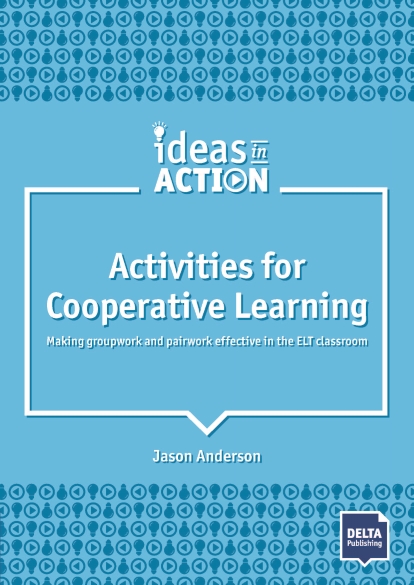Activities for Cooperative Learning is one of two new titles inaugurating a new series from Delta Publishing called ‘Ideas in Action’. The idea behind the series is to link the theory behind a specific aspect of teaching or language learning with activities that teachers can use in their own classroom. This blog post provides a brief introduction to my contribution to the series. See here on Delta Publishing. Available here on Amazon.
Who’s it for and what’s in it?
Activities for Cooperative Learning is designed for teachers of teens and adults from A1 to C1 proficiency levels. It includes over 30 activity types, each of which is accompanied by a ready-to-go photocopiable example to try out in the classroom. However, the book isn’t simply a supply of ready-to-go lessons — like other titles in the Ideas in Action series, teachers are provided with guidance to help them develop their own materials based on the examples activities, so that they can adapt the ideas to the needs of their own learners and their particular teaching context. The book also provides a full introduction to Cooperative Learning, written specifically with the EFL/ESL classroom in mind. It includes suggestions for Micro-strategies and Tools that will support your Cooperative Learning activities, linked to example units throughout the book.
Why Cooperative Learning?
“It is not the similarity or dissimilarity of individuals that constitutes a group, but interdependence of fate.”
Kurt Lewin, 1939
Terms such as ‘cooperative learning’, ‘collaborative learning’ and ‘interactive learning’ are often used interchangeably in conversations and articles about teaching to invoke the same basic idea—that of learners working together in the classroom. However, the first of these, Cooperative Learning, has a particular history and specific principles that are often overlooked in more general discussions of learner-centred teaching.
Cooperative learning evolved in the late 1960s and early 1970s in the USA, when desegregation was occurring across the country. The challenges it presented led a number of methodologists and researchers to try out innovative ideas, based on earlier research by psychologists Kurt Lewin (e.g., 1939) and Morton Deutsch (e.g., 1973). It is notable that many of the early innovators in Cooperative Learning were also psychologists, including Elliot Aronson, Robert Slavin, and brothers David and Roger Johnson, who were the first to describe the principles and theory of Cooperative Learning (1975).
Cooperative Learning and Communicative Language Teaching (CLT)
Many of the activity types used in Cooperative Learning will be familiar to communicative language teachers, because Cooperative Learning has already had a significant—albeit rarely acknowledged—influence on CLT. Activities such as jigsaw reading (Aronson et al., 1975) and other information gap activities, (e.g., describe and draw), as well as more creative interaction patterns, and the extensive use of peer consultation (e.g. ‘Think-Pair-Share’) all originate in the work of early Cooperative Learning innovators. However, while CLT inherited all these activities from Cooperative Learning, it seems that two core principles important to making Cooperative Learning effective were overlooked (Anderson, 2019b); positive interdependence and individual accountability.
Positive Interdependence and Individual Accountability
Different writers on Cooperative Learning often emphasise a wide range of principles underpinning the approach, and even disagree about which ones are most important. However, a close reading of their work reveals that there are two core principles that they all agree upon (e.g., Johnson & Johnson, 1994; Kagan & Kagan, 2009; Slavin, 1995), and which I present as central to effective cooperation in the book (Anderson, 2019a):
- Positive interdependence: For an activity to be truly cooperative, group members must work as a team towards a shared goal, not in competition with each other, so that they sink or swim together.
- Individual accountability: Group success depends on contributions from all group members, making each learner accountable, both for their own learning, and for contributing to the group as required.
While many collaborative activities can be successful without these two principles (for example, in small classes of motivated adult learners), it is in contexts where collaboration is most challenging that awareness and application of these principles can mean the difference between success and failure (or chaos!) in the classroom. Particularly in secondary contexts, where learners may be less motivated, more self-conscious and even rebellious, these principles can constitute a key bonding force that can bring them together. But there is also evidence that these principles can make it successful in other contexts where collaboration can be challenging, such as large classrooms, low-resource contexts, and countries where educational traditions have not previously prioritised collaboration (see, e.g., Ghaith & Kawtharani, 2006; Ning, 2010; Panhwar, 2016).
A simple example: ‘Synthesis questions’ in Jigsaw
So far, fine, I bet you’re thinking. But how do these principles influence the activities we do in the classroom?
Let’s look at an example familiar to most English teachers – Jigsaw reading activities, in which different learners read different texts (or sections of a longer text) and then communicate their content with each other. Many jigsaws used in ELT today tend to require students simply to read and ‘regurgitate’ (as an old colleague used to put it) the contents with very little aim or meaningful communicative intent. The questions we provide often encourage only this, and as a result learners often fail to process the text and simply read out key sentences, rarely listening to each other.
‘Synthesis questions’, as I call them, can avoid this, and ensure that a jigsaw involves both positive interdependence and individual accountability. In one example from my book, learners read one of four texts on different people with different jobs. The jobs are pretty unexciting, but the texts do expose them to useful vocabulary and structures used to talk about jobs and work, so meaningful processing of the content should lead to some acquisition. Rather than getting them simply to ask and answer typical comprehension questions such as: ‘How much does she/he earn?’, ‘Does she/he enjoy her/his job?’, etc., the synthesis questions provided ask questions such as: ‘Who works hardest?’ ‘Who is happiest? Why do you think this?’, etc. This requires the learners to compare the four texts, focus in on key details, and then engage in collaborative, higher-order thinking skills, such as evaluating, synthesising and inferring. If just one member of the group doesn’t contribute appropriately, the group can get the answers wrong, ensuring individual accountability. The group members listen carefully to each other, check important vocabulary and help each other to understand their individual texts, thereby encouraging positive interdependence… at least in theory. Try it out and let me know if it works in your classroom!
In the Feature article from English Teaching Professional, March 2019 issue, I discuss other ways in which Cooperative Learning can support teachers interested in issues such as effective differentiation, preventing one or two learners dominating groupwork, and encouraging communication in exam-dominated cultures.
Research on Cooperative Learning
“There seems a universal agreement that Cooperative Learning is effective, especially when contrasted with competitive and individualistic learning”
John Hattie, 2008
Despite being relatively unknown within ELT, Cooperative Learning is one of the most extensively researched ‘approaches’ in mainstream teaching, with over 1,200 studies conducted on it. Hattie (2008) reports some of the largest effect sizes of any “method” (0.41 to 0.59; Cohen’s d) for Cooperative Learning in his study, and Marzano’s (1998) meta-analysis reports even larger effect sizes, indicating that it can be effective in a wide range of contexts.
Critical reading encouraged

However, this doesn’t mean that it should be applied uncritically. Like all approaches, adaptation to your own context is necessary when introducing cooperative practices in your own classroom. While some of the studies included in the meta-analyses above were from foreign language classrooms, Cooperative Learning was not designed specifically for language learning, so adaptations and critical appropriation from its core principles and ideas are always encouraged, and important, given Cooperative Learning’s interactive nature and implicit belief in peer-teaching and dialogic learning.
My book is available on Amazon, and from the Delta Publishing website. Feedback, both positive and critical, is always received with interest.
References
Anderson, J. (2019a). Activities for cooperative learning. Stuttgart: Delta Publishing/Ernst Klett Sprachen GmbH.
Anderson, J. (2019b). Cooperative learning: Principles and practice. English Teaching Professional 121, 4-6.
Aronson E., Blaney, N., Sikes, J., Stephan, C., & Snapp, M. (1975). The jigsaw route to learning and liking. Psychology Today 8, 43-50.
Deutsch, M. (1973). The resolution of conflict: Constructive and destructive processes. Binghampton, NY: Vail-Ballou.
Ghaith, G., & Kawtharani, A. (2006). Using cooperative learning with primary school students. In S. G. McCafferty, J. M. Jacobs, & A. C. DaSilva Iddings (Eds.), Cooperative learning and second language teaching (pp. 74-91). Cambridge, UK: Cambridge University Press.
Hattie, J. (2008). Visible learning: A synthesis of over 800 meta-analyses relating to achievement. Abingdon, UK: Routledge.
Johnson, D. W., & Johnson, R. T. (1975). Learning together and alone. Englewood Cliffs, NJ: Prentice-Hall.
Johnson R. T., & Johnson, D. W. (1994). An overview of cooperative learning. In J. Thousand, R. Villa, & A. Nevin (Eds.), Creativity and collaborative learning: A practical guide to empowering students and teachers (pp. 31-43). Baltimore, MD: Brookes Press.
Kagan, S. and Kagan, M. (2009) Kagan cooperative learning. San Clemente, CA: Kagan Publishing.
Lewin, K. (1939). When facing danger. In K. Lewin (Ed.), Resolving social conflicts and field theory in social science (pp. 116-121). Washington, DC, American Psychological Association.
Marzano, R. J. (1998). A theory-based meta-analysis of research on instruction. Aurora, CO: Mid-continent Research for Education and Learning.
Ning, H. (2010). Adapting cooperative learning in tertiary ELT. ELT Journal, 65(1), 60-70.
Panhwar, A. H. (2016). Using cooperative learning to enhance student engagement with language support classes in Pakistani higher education (Unpublished doctoral dissertation). Anglia Ruskin University, Cambridge, UK.
Slavin, R. E. (1995). Cooperative learning: Theory, research, and practice. (2nd ed.). Needham Heights, MA: Allyn and Bacon.
